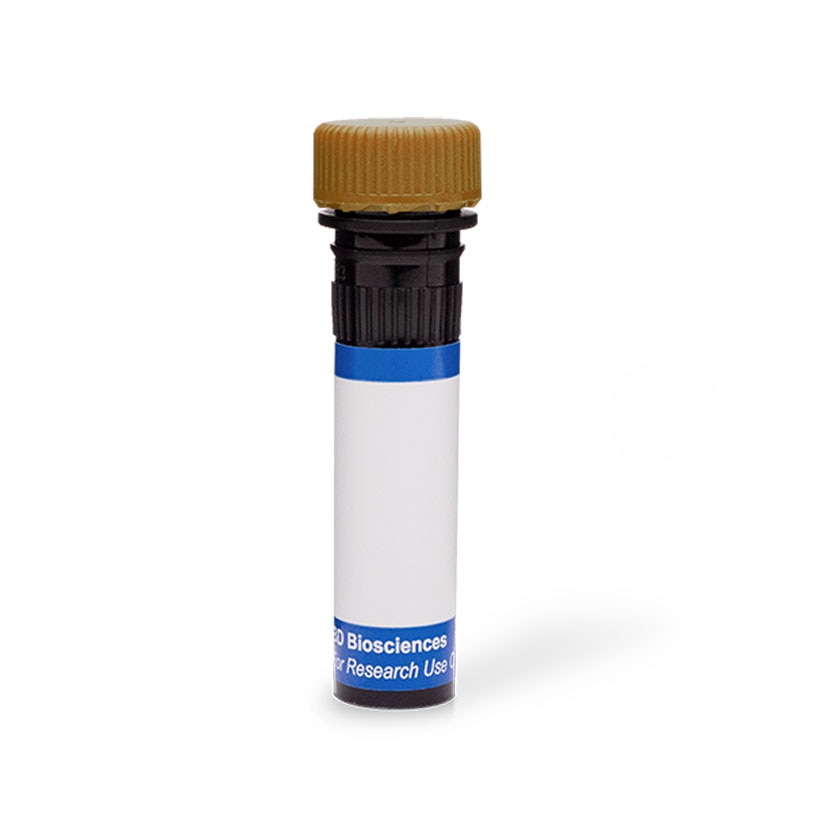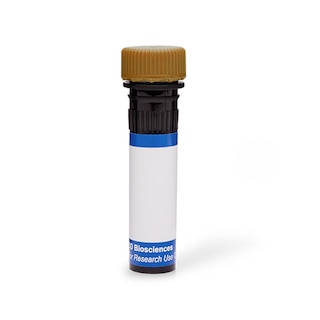Old Browser
This page has been recently translated and is available in French now.
Looks like you're visiting us from {countryName}.
Would you like to stay on the current country site or be switched to your country?






Flow cytometric analysis using BD OptiBuild™ RB705 Rat Anti-Mouse CD124 antibody (Cat. No. 757128; solid line histogram) on viable BALB/c Mouse splenocytes, with corresponding IgG Isotype Control (Cat. No. 570262; dashed line histogram). Samples were acquired on the BD FACSymphony™ A5 SE Cell Analyzer.

Flow cytometric analysis using BD OptiBuild™ RB705 Rat Anti-Mouse CD124 (IL-4 Receptor) antibody (Cat. No. 757128; solid line histogram) on viable BALB/c Mouse splenocytes, with corresponding IgG Isotype Control (Cat. No. 570262; dashed line histogram). Samples were acquired on the BD FACSymphony™ A5 SE Cell Analyzer.


BD OptiBuild™ RB705 Rat Anti-Mouse CD124

BD OptiBuild™ RB705 Rat Anti-Mouse CD124 (IL4-Receptor)

Regulatory Status Legend
Any use of products other than the permitted use without the express written authorization of Becton, Dickinson and Company is strictly prohibited.
Preparation And Storage
Recommended Assay Procedures
BD® CompBeads can be used as surrogates to assess fluorescence spillover (compensation). When fluorochrome conjugated antibodies are bound to BD® CompBeads, they have spectral properties very similar to cells. However, for some fluorochromes there can be small differences in spectral emissions compared to cells, resulting in spillover values that differ when compared to biological controls. It is strongly recommended that when using a reagent for the first time, users compare the spillover on cells and BD® CompBeads to ensure that BD® CompBeads are appropriate for your specific cellular application.
Product Notices
- When using high concentrations of antibody, background binding of this dye to erythroid fragments produced by ammonium chloride-based lysis, such as with BD Pharm Lyse™ Lysing Buffer (Cat. No. 555899), has been observed when the antibody conjugate was present during the lysis procedure. This may cause nonspecific staining of target cells, such as leukocytes, which have bound the resulting erythroid fragments. This background can be mitigated by any of the following: titrating the antibody conjugate to a lower concentration, fixing samples with formaldehyde, or removing erythrocytes before staining (eg, gradient centrifugation or pre-lysis with wash). This background has not been observed when cells were lysed with BD FACS™ Lysing Solution (Cat. No. 349202) after staining.
- The production process underwent stringent testing and validation to assure that it generates a high-quality conjugate with consistent performance and specific binding activity. However, verification testing has not been performed on all conjugate lots.
- Please refer to www.bdbiosciences.com/us/s/resources for technical protocols.
- Since applications vary, each investigator should titrate the reagent to obtain optimal results.
- An isotype control should be used at the same concentration as the antibody of interest.
- Please observe the following precautions: We recommend that special precautions be taken (such as wrapping vials, tubes, or racks in aluminum foil) to protect exposure of conjugated reagents, including cells stained with those reagents, to any room illumination. Absorption of visible light can significantly affect the emission spectra and quantum yield of tandem fluorochrome conjugates.
- Caution: Sodium azide yields highly toxic hydrazoic acid under acidic conditions. Dilute azide compounds in running water before discarding to avoid accumulation of potentially explosive deposits in plumbing.
- For fluorochrome spectra and suitable instrument settings, please refer to our Multicolor Flow Cytometry web page at www.bdbiosciences.com/colors.
- Please refer to http://regdocs.bd.com to access safety data sheets (SDS).
- Cy is a trademark of Global Life Sciences Solutions Germany GmbH or an affiliate doing business as Cytiva.
- For U.S. patents that may apply, see bd.com/patents.
Companion Products




The mIL4R-M1 monoclonal antibody specifically binds to CD124 which is also known as the α subunit of the mouse Interleukin-4 Receptor (IL-4Rα). The mouse IL-4Rα is a 140 kDa transmembrane glycoprotein that is expressed by B and T lymphocytes and a variety of other hematopoietic and nonhematopoietic cells and cell lines. The cell surface IL-4Rα chain binds IL-4 with high affinity and associates with either the common γ chain (IL-4Rα/γc; aka, type I IL-4R) or the IL-13 receptor alpha subunit (IL-4Rα/IL-13Rα; aka, type II IL-4R complex) to form two distinct types of signal-transducing IL-4R complexes. The type I IL-4 receptor complex specifically binds IL-4 whereas the type II IL-4R binds and transduces signals from either IL-4 or IL-13. The mIL4R-M1 antibody blocks IL-4 binding to cells and is reported to be a potent inhibitor of IL-4's biological activities. The mIL4R-M1 antibody also recognizes naturally-occurring, soluble truncated forms of IL-4Rα (sIL-4R) that result either from enzymatic cleavage of the cell surface extracellular IL-4Rα domain or from differential mRNAsplicing and secretion by cells. These sIL-4R retain their high-affinity ligand binding domain and appear to either enhance or inhibit IL-4-mediated functions depending on the relative local levels of IL-4 and sIL-4R.

Development References (9)
-
Beckmann MP, Schooley KA, Gallis B, et al. Monoclonal antibodies block murine IL-4 receptor function. J Immunol. 1990; 144(11):4212-4217. (Immunogen: Blocking, Immunoprecipitation, Inhibition, Neutralization, Radioimmunoassay). View Reference
-
Chilton PM, Fernandez-Botran R. Production of soluble IL-4 receptors by murine spleen cells is regulated by T cell activation and IL-4. J Immunol. 1993; 151(1):5907-5917. (Clone-specific: ELISA). View Reference
-
Feldman GM, Ruhl S, Bickel M, Finbloom DS, Pluznik DH. Regulation of interleukin-4 receptors on murine myeloid progenitor cells by interleukin-6. Blood. 1991; 78(7):1678-1684. (Clone-specific: Flow cytometry). View Reference
-
Gessner A, Rollinghoff M. Biologic functions and signaling of the interleukin-4 receptor complexes. Immunobiology. 2000; 201(3-4):285-307. (Biology). View Reference
-
Hassuneh MR, Nagarkatti PS, Nagarkatti M. Evidence for the participation of interleukin-2 (IL-2) and IL-4 in the regulation of autonomous growth and tumorigenesis of transformed cells of lymphoid origin. Blood. 1997; 89(2):610-620. (Clone-specific: Flow cytometry). View Reference
-
Kubo M, Yamashita M, Abe R, et al. CD28 costimulation accelerates IL-4 receptor sensitivity and IL-4-mediated Th2 differentiation. J Immunol. 1999; 63(5):2432-2442. (Clone-specific: Flow cytometry). View Reference
-
Lowenthal JW, Castle BE, Christiansen J, et al. Expression of high affinity receptors for murine interleukin 4 (BSF-1) on hemopoietic and nonhemopoietic cells. J Immunol. 1988; 140(2):456-464. (Biology). View Reference
-
Mosley B, Beckmann MP, March CJ, et al. The murine interleukin-4 receptor: molecular cloning and characterization of secreted and membrane bound forms. Cell. 1989; 59(2):335-348. (Biology). View Reference
-
Sempowski GD, Beckmann MP, Derdak S, Phipps RP. Subsets of murine lung fibroblasts express membrane-bound and soluble IL-4 receptors. Role of IL-4 in enhancing fibroblast proliferation and collagen synthesis. J Immunol. 1994; 152(7):3606-3614. (Clone-specific: Flow cytometry). View Reference
Please refer to Support Documents for Quality Certificates
Global - Refer to manufacturer's instructions for use and related User Manuals and Technical data sheets before using this products as described
Comparisons, where applicable, are made against older BD Technology, manual methods or are general performance claims. Comparisons are not made against non-BD technologies, unless otherwise noted.
For Research Use Only. Not for use in diagnostic or therapeutic procedures.